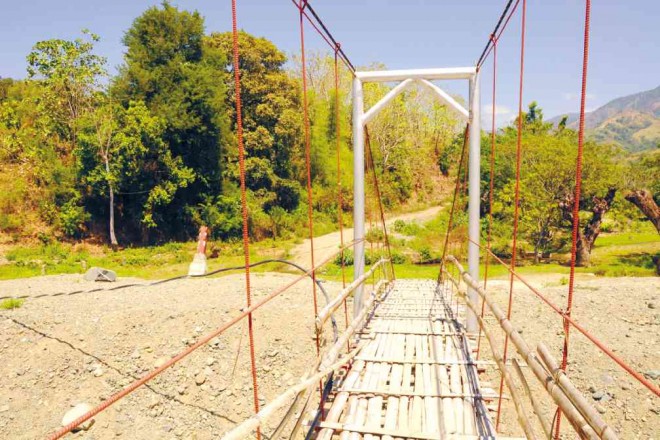Historic road linking Ilocos, Cagayan Valley to open next year

START OF TRAIL The Red Arrow 32nd Division of the US Army Memorial marker at the edge of the Cabalisian River. The Villa Verde Trail starts here. WILLIE LOMIBAO / INQUIRER NORTHERN LUZON
LINGAYEN, Pangasinan—By 2016, the second major road line linking the Ilocos and Cagayan Valley regions will be open to vehicular traffic, a Department of Public Works and Highways (DPWH) official said here on Monday.
Ronnel Tan, DPWH assistant regional director in the Ilocos, said work had begun to convert the 23-kilometer Pangasinan segment of the Villa Verde Trail in San Nicolas town into a two-lane highway that would connect to the already paved road in Nueva Vizcaya province.
The Villa Verde Trail, which was used by the Allied Forces in chasing Japanese soldiers during World War II, crosses the Caraballo Mountains from Barangay Sta. Maria East in San Nicolas town to Barangay Imugan in Sta. Fe, Nueva Vizcaya.
The only road now linking the Ilocos and Cagayan Valley regions is the Maharlika Highway, which starts from Laoag City in Ilocos Norte province and cuts through Cagayan Valley provinces before leading south to Central Luzon.
Article continues after this advertisementTan said the Villa Verde Trail project had been allocated P300 million this year. This will be used for the construction of a 63-lineal meter bridge and for the opening of the 13-km portion of the road.
Article continues after this advertisement“In 2016, we will have P280 million, which will be spent for the opening of the rest of the road and for the construction of three bridges. In 2017 and 2018, hopefully this road will already be paved,” he said.
By next year, vehicles may already pass through the road, even if it is not paved yet.
Board Member Ranjit Shahani said the road was supposed to have been completed “a long time ago” when the US Agency for International Development (USAID) provided the funding for its construction.
“Unfortunately, the first phase encountered some opposition from the IPs (indigenous peoples), the Ikalahan tribe, who inhabited the upland portion,” Shahani said.
He said a Scottish missionary, Rev. Delbert Arthur Rice, who led members of the Ikalahan tribe, was against the road construction, saying plants and animals in the area will be disturbed once the project starts.
“But an environmental impact statement on the project showed there was no environmental hazard for that construction,” Shahani said.
“So, what happened was the USAID decided to use the money to do the ground base portion of the road from Rosales town all the way to San Nicolas. For the upland portion, the money was never used,” he said.
The San Nicolas municipal library website said Malico, in the 1970s, could be reached easily by motor vehicles from the town proper through the winding Villa Verde Trail. However, the July 1990 Luzon earthquake triggered landslides that destroyed sections of the road.
Shahani said the opening of a road linking Ilocos and Cagayan Valley regions would spur economic development and trade in eastern Pangasinan towns, which, he said, had been hampered because of the Caraballo Mountains.
The road opening, he said, will also make it easier for residents in the mountainous village of Malico to travel to the San Nicolas town center.
San Nicolas Mayor Rebecca Saldivar said the road reopening would mean additional livelihood opportunities to residents of Malico, a vegetable-growing village. Residents of Malico plant cabbage, sayote and lettuce, she said.
The Department of Agriculture, she said, has put up a P10-million greenhouse to grow strawberry in the village.
“In the near future, perhaps, we can claim that San Nicolas will be the ‘summer capital of Pangasinan,’” Saldivar said.
Councilor Danilo Bugtong, IP representative to the San Nicolas council, said he needed to drive for four hours every Monday from his house in Malico to reach the municipal hall in time for the flag-raising ceremony at 8 a.m.
This is because his trip takes him to a circuitous route passing through Sta. Fe in Nueva Vizcaya, and San Jose City and Lupao town in Nueva Ecija province, then through the towns of Umingan, San Quintin and Tayug in Pangasinan before reaching San Nicolas.
